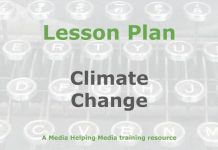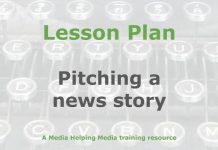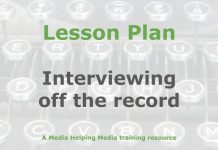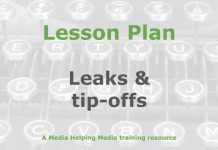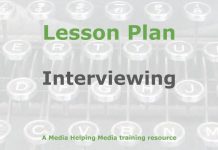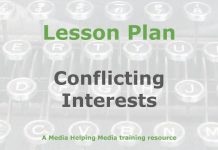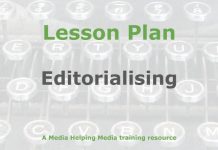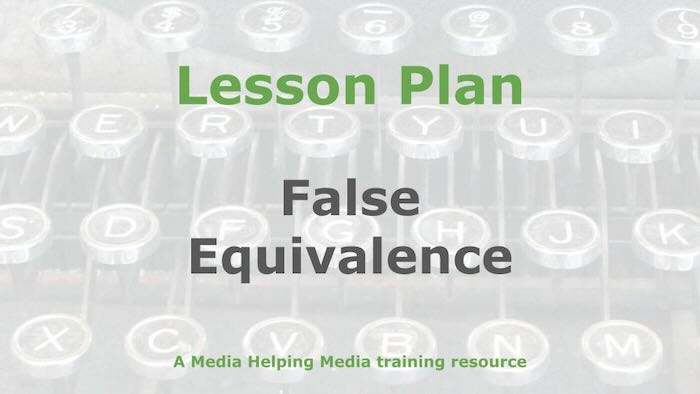 This lesson plan is designed to help students avoid applying false equivalence and false balance to their news writing.
This lesson plan is designed to help students avoid applying false equivalence and false balance to their news writing.
It’s based on the article ‘False equivalence and false balance‘, which we suggest you read before adapting the lesson outline for your own purposes.
Learning objective
Students will identify and evaluate instances of false equivalence and false balance in journalistic content. They will also apply critical thinking skills to assess the validity of arguments and evidence presented in media reports.
- Student-facing objective: By the end of this lesson, the student will be able to spot when news stories make unfair comparisons or give equal weight to unequal arguments, and explain why it’s important to avoid these mistakes.
- Standards: Journalists can sometimes present an inaccurate or misleading version of events by making a simple common mistake. We either try too hard to ‘balance’ a story then end up distorting the facts, or we assess contributors or actors in our story as being roughly equal when in fact they are not. This module looks at ways of avoiding two errors, applying ‘false equivalence’ and ‘false balance’.
Learning activities
Warm-up
Present students with two brief news headlines. One headline should clearly demonstrate false equivalence, and the other should demonstrate false balance. For example:
- “All politicians are corrupt, just like criminals.”
- “Climate change debate: Scientists vs. skeptics.”
Ask students to read both headlines and discuss with a partner which headline might be misleading and why. Encourage them to consider whether the comparisons or balances presented are fair or accurate. After a few minutes, facilitate a brief class discussion to share insights.
Direct instruction
Introduce concepts: Begin by defining false equivalence and false balance. Use real-world examples to illustrate each. For false equivalence, explain the statement “All politicians are the same” and discuss why this is misleading. For false balance, use the climate change debate, highlighting the disparity in scientific consensus versus minority skepticism.
Analyse examples: Present a news article excerpt that contains either false equivalence or false balance. Ask students to identify which error is present and justify their reasoning.
Use a structured approach:
- Identify the claim or comparison.
- Evaluate the evidence or arguments presented.
- Determine if the comparison or balance is justified.
Critical evaluation: Provide students with a checklist to evaluate news stories for false equivalence and false balance. Include questions such as:
- Are the compared items truly similar in all relevant aspects?
- Does the evidence support equal weight to both sides?
- Is there a significant difference in the credibility or quantity of evidence for each side?
Discuss how applying this checklist can improve their media literacy and critical thinking skills.
Guided practice
Think, Pair, Share: Distribute a short article or excerpt containing potential false equivalence or false balance.
- Think: Individually, students read the article and note any instances of false equivalence or false balance. Encourage them to use the checklist from direct instruction.
- Pair: Students pair up to discuss their findings. Each student explains their reasoning and listens to their partner’s perspective. They should focus on identifying the type of error and justifying their conclusions.
- Share: Facilitate a class discussion where pairs share their insights. Encourage students to compare their analyses and refine their understanding based on peer feedback.
- Clarify: As a class, clarify any misconceptions and reinforce the correct identification of false equivalence and false balance.
- Reflect: Ask students to reflect on how this exercise enhances their ability to critically evaluate media content.
Independent practice
- Assign students an online exercise where they identify false equivalence and false balance in various news articles.
- Instruct students to write a brief analysis of one article, highlighting the errors and suggesting how the article could be improved.
- Encourage students to apply the checklist from direct instruction to support their analysis.
Circulate to provide guidance and answer questions as needed.
Assignment
Ask students to answer these questions:
- How can false equivalence distort the truth in a news story?
- Why is it important to recognise false balance in media reports?
- What’s one question you still have from today’s lesson?
Here are some suggested answers:
- Suggested answer to Question 1: False equivalence can make different things seem the same, misleading the audience about their true nature.
- Suggested answer to Question 2: Recognising false balance is crucial because it prevents giving undue weight to less credible arguments, ensuring accurate representation of facts.
Teacher resources
Differentiation guide
- Advanced learners: Encourage deeper analysis by having students research and present additional real-world examples of false equivalence and false balance. Challenge them to explore the impact of these errors on public perception and policy. Consider assigning a debate where they must argue against a position that uses these errors, requiring them to refute misleading comparisons or balances.
- Striving learners: Simplify the concepts with more relatable examples. Use visual aids like Venn diagrams to illustrate differences in false equivalence scenarios. Provide sentence starters or templates to help them articulate their thoughts during discussions. Pair them with peers who can support their understanding during activities.
- Background reading: This lesson plan is based on the article ‘False equivalence and false balance‘, which we suggest you read before adapting the lesson outline for your own purposes.
Notable definitions
- False equivalence: A logical fallacy where two or more things are incorrectly presented as equal or similar, despite significant differences. Example: Claiming “all politicians are the same” ignores their diverse policies and actions.
- False balance: A journalistic error where two sides of an argument are given equal weight, despite one side having significantly more evidence or credibility. Example: Presenting climate change skeptics as equal to the scientific consensus.
- Misinformation: False or misleading information spread unintentionally. It can result from errors like false equivalence and false balance, leading to public misunderstanding.
Required materials
- News article excerpts demonstrating false equivalence and false balance
- Checklist for evaluating news stories
- Short articles or excerpts for guided practice
- Online exercise link for independent practice
- Assignment questions for reflection
Lesson summary
- Warm-up
- Direct instruction
- Guided practice
- Independent practice
- Assignment
The free teaching tools at the Khan Academy were used as a basis for converting the original article into a lesson plan.
Related article
